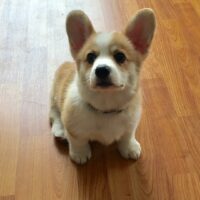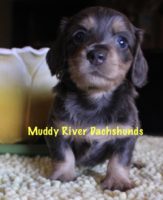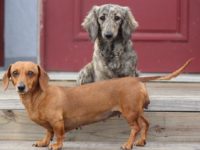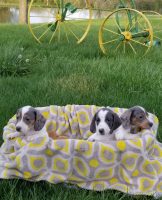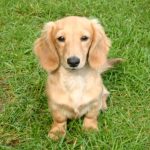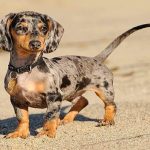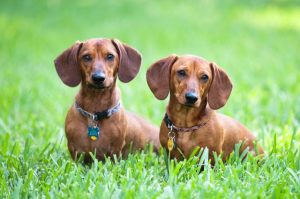 Known for their short legs and iconic elongated torsos, the Dachshund stands out in a crowd. Originally developed as a hunting dog, this breed has a strong sense of smell and a surprising amount of power in a small body. Owing to their keen sense of smell, this breed is technically classed as a hound. However, they also display characteristics typical of a terrier, such as a propensity for digging.
Known for their short legs and iconic elongated torsos, the Dachshund stands out in a crowd. Originally developed as a hunting dog, this breed has a strong sense of smell and a surprising amount of power in a small body. Owing to their keen sense of smell, this breed is technically classed as a hound. However, they also display characteristics typical of a terrier, such as a propensity for digging.
Breed Sizes
The breed comes in both standard and miniature sizes. A standard size dog weighs anywhere from 16 to 30 pounds and has a shoulder height of about eight to nine inches. The upper weight limit for a miniature dog is 12 pounds, and their typical height is five to six inches.
Size is the primary physical difference between the standard and miniature varieties, with both having the same body proportions and coat colors. There are some minor differences in personality traits, however. The standard size will typically have a calmer reaction to changes in its environment, while and the miniature usually responds better to training. Both size varieties enjoy children, but the miniature seems to be especially comfortable with them.
Coat Colors and Patterns
Dachshunds can have either a smooth, long-haired or wire-haired coat. A smooth coat consists of short hairs that lay flat and give the dog a sleek look. A long-haired coat has short, smooth hair on the face and long, silky hair on the dog’s ears and body. These long hairs fall in soft wisps and have a slight sheen. This coat type has wiry eyebrows and a beard on the face, and the body is covered with short, dense hairs that have a bristly feel. While the wire-haired coat is the most common type in Germany, it is not frequently seen in North America.
Coat colors come in many shades and can have a variety of patterns. The most common colors are a black and tan pointed pattern and various shades of solid red. Other coat colors include solid cream, black and cream pointed and chocolate and tan pointed. Coat patterns include brindle, dapple, piebald and sable.
Temperamental Qualities
Dachshunds are a lively mix of intelligence, loyalty, and fun. They can quickly learn new games and may try to make up their own ways of winning. They enjoy playtime and are often very good with children, making them a great family pet. Intense loyalty is characteristic of this breed, and they often form a strong bond with one special person. However, they can become overprotective of their owners and be bad-tempered with strangers in the absence of appropriate socialization.
While Dachshunds will always appreciate taking a walk around the block, their outdoor exercise requirements are minimal. They can almost always find something interesting to occupy their attention while indoors and thrive even in a small living space such as an apartment.
This breed has a tendency to be vocal. Their large chests house a generous lung capacity, resulting in a bark that is louder than their small size would lead one to expect.
Health and Potential Concerns
The average life expectancy for both standard and miniature sizes is 12 to 14 years. The most common health concerns are spinal problems and a tendency to gain weight easily.
With their long spines, Dachshunds are prone to suffer from slipped or herniated disks. Providing proper support while picking up or holding the dog can help prevent spinal trauma. Injuries can also occur from jumping off a couch or bed. Safety precautions should be taken, such as training the dog not to jump or modifying the furniture by adding a set of small stairs.
Excess weight can also cause back problems as the heavy stomach puts an extra downward strain on the spine. Ensuring a proper diet and providing stimulating activities can help prevent excessive weight gain.
Dogs with long- or wire-haired coats will need daily brushing to avoid tangles and matting. Those with smooth coats have minimal grooming needs.
The Dachshund in History
The breed has its origins in 18th century Germany where they were used to aid in hunting animals with underground dens. Badgers were the primary target for standard size dogs to hunt, either singly or in packs. The miniature variety was developed for hunting small game animals. Their name literally means “badger hound” in German. These dogs used their keen sense of smell to locate the animals, and their large front paws and strong shoulder muscles enabled powerful digging to drive the animals out of their dens.
